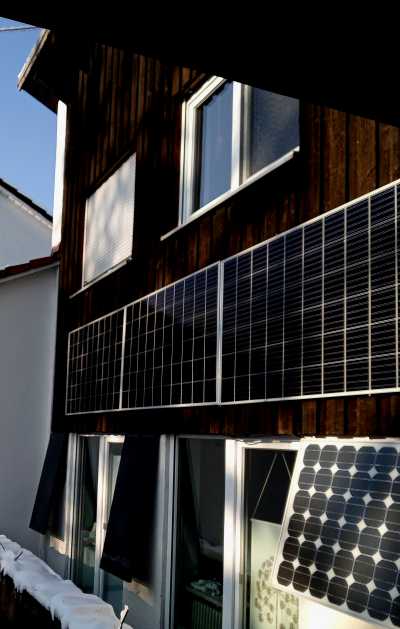
Three Years 'EMCOMM Ready' |
|
On the page Configuration of an EMCOMM Power Supply I showed my concept of an EMCOMM power supply for 24/7 operation. This article describes my experiences since I removed the last conventional power supply from my station. This does not mean that my station is fully off-grid – the German winter is against it. But I always keep at least 1/3 of my storage capacity in the batteries. This is a completely different operation mode than most owners of solar systems with battery storage use: They want a fully charged battery when the sun goes down and an empty battery in the morning when they leave their home. That way they save the most money while I want to ensure to have a minimum of electriity at all times. ContentsExpansion and SavingsUp to that point I had used AGM batteries that I mostly got used and quite cheaply. The expansion began 2022 with two LFP (LiFePO4) batteries 12.8 V/150 Ah each in the basement. There are two batteries for two reasons:

At the same time, I bought three 335 Wp solar modules. I connected them to one string, so I got a solar voltage of 90-110 V. Without excessive losses from typically less than 5 A I could use a 2.5 mm2 line. The old solar modules and AGM batteries continued to power the shack. You see this combination on the right. The new system was to power the fridge-freezer combination. Then a new fridge-freezer combination with EU energy classification A cut three quarters of the power consumption on 230 V level or from about 1 kWh/day to 0,4 kWh/day on 12 V level, including the inverter losses. Technology Update in the ShackThe old AGM batteries lost more and more capacity. I replaced them with two 100 Ah LFP batteries. Next I also replaced the computer in the shack. From then on, one of the 335 Wp solar panels could power the shack for about 10 months a year. In the photo you can also see why this does not work in the winter: 20 m high trees 25 m south of my house shade the complete house around Christmas. The remaining two 335 Wp solar panels could now easily power the fridge and a few kitchen appliances. Sometimes even these two solar panels can provide more power than the 490 W the 35 A controller can accept. This does not happen in the summer, but in spring and autumn: The sun stands lower and the temperatures are lower. The solar current is proportional to the light intensity, but the solar voltage depends on the temperature of the solar modules. Lower temperatures mean higher voltage. You know this from every silicon diode or bipolar transistor. My Ham Radio EquipmentPrimarily, I want to do regional EMCOMM, up to about 1000 km. My IC-705 is a feature rich QRP radio that covers all relevant bands and can be easily connected to a computer via an USB cable. If the 10 W should not be enough, I have a 40 W shortwave PA. So far, I can use the historical bands 80/40/20/10m:
As long as FM relay DB0ZU is QRV I have a reach of more than 100 km to the north and west. DB0XF is known to have a reasonable EMCOMM power supply, allowing me to cover about 80 km to the north. Depending on the partner station I have a direct reach of up to 50 km. I am concentrating on digital modes because this way my station can offer useful services even while I am not available.
A nice test happened during the camping holiday of a Munich ham in Scandinavia in August 2025: We exchanged vmails nearly daily. Bottom LineA reasonable EMCOMM power supply costs less than a higher-quality shortwave transceiver. You can easily reduce standby power consumption below 20 W or 0.5 kWh/day, if you use a QRP transceiver and a computer with a modern low-power CPU (10 nm structures) and a miniature computer with direct 12 V supply. An external power amplifier complicates the installation, but with a QRP transceiver it provides the lowest power consumption. The cheapest part are solar panels. You get 500 Wp for about 100 EUR and you might need only one. You can operate an EMCOMM station without solar panels if you must, but this greatly reduces your off-grid operation time as batteries are expensive. If your station consumes around 20 W as mine does, 200 Ah/12 V batteries give you around 100 hours or four days of continuous operating time. A single, standard solar panel should add unlimited operation time for 95% of the time – at least here at 49° north. My biggest EMCOMM problem is the missing EMCOMM infrastructure: Very few hams in my area are interested in this topic and there is no agreed upon organization. This will change as soon as disaster strikes, but then it is too late for most. There should be a few hams with batteries in the shack and a few relays with backup power. The rest we will have to organize on the fly. I think we will mostly use FM and VarAC to organize something. Until then I can only publish information like here. |
|
Alexander von Obert * http://www.dl4no.de/thema/threeyea.htm Letzte Änderung: 24.08.25 (first version) |
EMCOMM
| EMCOMM Basic Facts |
| Information Gathering and Distribution |
| Minimal, Individual Preparation for EMCOMM |
| Configuration of an EMCOMM Power Supply |
| Computers for EMCOMM |
| Three Years 'EMCOMM Ready' |